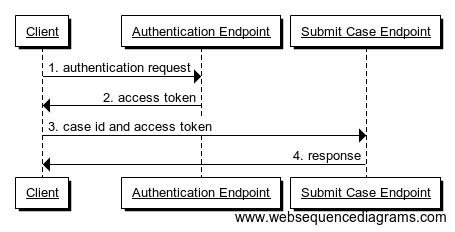GETTING STARTED
INSURANCE COMPANY STORIES
SERVICE PARTNER STORIES
API BASICS
API ENDPOINTS
COMPONENTS
LEGACY
Submit Case API
Introduction
This document describes the ClaimShop Self-Service submit case API. This API can be used to submit data (of specific case) from Scalepoint Self-Service solution to be imported into ClaimShop case.
Main consumer of this API is insurance company.
Overview
The process of Submitting settlement data can be divided into two steps:
- Authentication
- Submit loss data
Authentication
You need an access_token in order to send data to the Submit Case Endpoint. This access token can be obtained from the Authentication Endpoint. Please refer to the documentation about details of authentication process.
API caller should request self-service:submit scope from Authentication Endpoint.
Endpoints
Authentication endpoint
For authentication Scalepoint provides two endpoints – one for production and one for everything else.
Production endpoint
https://accounts.scalepoint.com/connect/token
Non-production endpoint
https://sandbox-accounts.scalepoint.com/connect/token
Submit Case API main endpoint
The endpoint which allows to submit any loss case by its token is in the following format:
https://www.scalepoint.com/self-service/<country>/api/<tenant>/case/<caseToken>/submitted
Here
The actual format of this will depend on the insurance company and the country in which it operates.
Assuming the following:
- Country:
Denmark - Tenant:
ABC Insurance - Case token :
d1a72df4-f7d5-402c-a495-cc31b8b39a59
The endpoint could look something like this:
https://www.scalepoint.com/self-service/dk/api/abcinsurance/case/d1a72df4-f7d5-402c-a495-cc31b8b39a59/submitted
For testing purposes, you will be given access to a project server and the hostname-part of the endpoint would change accordingly:
https://<hostname>/self-service/dk/api/abcinsurance/case/d1a72df4-f7d5-402c-a495-cc31b8b39a59/submitted
Please discuss with your account manager, which project server you have been assigned in order to determine the actual endpoint.
Submit Case
Post Submit Case Request
Submit Case POST request contains request parameters as a part of endpoint URL (see above) and authorization header.
Authorization header has name 'Authorization'. It has value built from access_token in following format:
Bearer access_token
Note the important space character between Bearer and access_token value.
Post Submit Case Response
In case of success HTTP response with status code 200 will be returned.
In case of error HTTP status and message code should be used to determine error type.
The content type of the response is "application/json".
{
"success":true,
"code":"SUCCESS"
}| Code | Sucess | HTTP Status | Description |
|---|---|---|---|
| SUCCESS | true | 200 | Case was successfully submitted |
| NO_LINES_TO_SUBMIT | true | 200 | There was attempt to submit case with no lines, which is prohibited |
| CASE_ALREADY_SUBMITTED | false | 400 | There was attempt to submit case again |
| CASE_IS_NOT_OPEN | false | 400 | There was attempt to submit not open case |
| AGREEMENT_NOT_ACCEPTED | false | 400 | Customer did not agree on condition (if presented) |
| CASE_NOT_FOUND | false | 400 | Case with such token was not found |
| INVALID_TENANT | false | 400 | Invalid tenant |
| INTERNAL_SERVER_ERROR | false | 500 | Internal server error |
| UNAUTHORIZED | false | 401 | access token is not valid |
see more about widget implementation:
